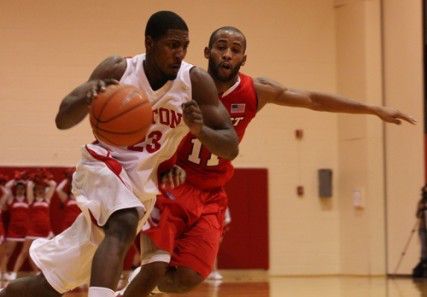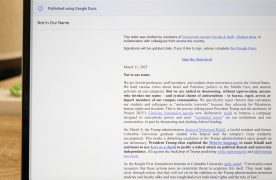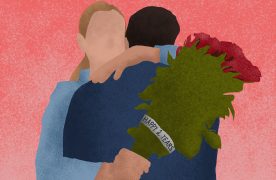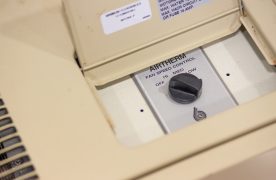Even for a man who dedicates so much effort, determination and focus to tapping at proverbial stones, Boston University men’s basketball coach Patrick Chambers is a relentless builder.

When he was first introduced as the Terriers’ next coach in April 2009, Chambers spoke of a vision that he had for the program moving forward, a vision that would hopefully one day make BU a nationally relevant mid-major. Inheriting a talented group of seniors with Corey Lowe, Carlos Strong and Tyler Morris from his predecessor Dennis Wolff, Chambers’ blueprint and plans for BU basketball began to come to fruition as the team hit its stride late in the season, going on a run that got it within one game of the NCAA Tournament.
The next logical step in this pseudo-construction project would be to lay the foundation, but entering the 2010-11 season, uncertainty reigned for what would be a very telling season in Chambers’ tenure.
Wolff’s former players were gone to graduation and filling that large void would be three transfers and seven freshmen brought in by Chambers.
Despite being picked yet again to finish first in the AE preseason coaches’ poll, there was a lingering doubt as to whether all these new parts could come together to form a strong, cohesive unit. The results of such an experiment could also have a large effect on the perception of Chambers’ plan for the program. After all, no building can stand on faulty groundwork.
Through much of the Terriers’ non-conference slate, such fears surrounding a remodeled team appeared justified. Though BU (21-14) got off to a respectable 4-3 start, highlighted by a 76-67 win over George Washington University in the Preseason National Invitational Tournament, it failed to find much consistency on a game-to-game basis and struggled shooting the basketball, shooting 40 percent or below from the field in five of its first seven games.
Even with solid and promising play from newcomers such as freshman guard D.J. Irving, freshman forward Dom Morris, junior guard Darryl Partin and junior guard Matt Griffin, the team’s overall lack of experience and familiarity of playing with one another was a large contributing factor in its early shortcomings.
“You’ve got freshmen who want to play but don’t know how hard you have to work every day in practice, how hard games are,” Chambers said. “I guess dysfunction’s probably not the right word, but we just had a lot of newcomers, a lot of growing pains.”
Despite strong, resilient play from forward John Holland, the preseason AE Player of the Year and the team’s only senior, the aforementioned growing pains only continued to mount as BU’s record plummeted.
Over the next month, the Terriers became mired in a slump, losing seven of their next eight games, including blowout losses at then-No. 11 University of Kentucky, Harvard University and University of Massachusetts. The loss to the Minutemen on Dec. 31 put BU’s overall record at 5-9 at the end of non-conference play and entering the New Year.
While such losses may have been disheartening at the time to an inexperienced team, Chambers felt that a rigorous non-conference schedule that featured the likes of Villanova University and Kentucky was necessary to bond his team together and force them to mature in the process.
“In the beginning, I knew we were going to take some lumps, I knew we were going to have some challenges,” Chambers said. “But you have to have a tough non-conference to toughen these guys up.”
Injuries to junior forward and tri-captain Jake O’Brien (foot) and Morris (non-basketball related), coupled with only one day of practice before its conference opener against University of Maine on Jan. 2, left BU undermanned and forced Chambers to mix and match different combinations on the floor. As a result, the Black Bears gave the Terriers a rude welcome to league play, beating them 65-52 at Alford Arena.
With more practices under their belts and ample time to mesh with one another, the Terriers responded with three straights wins over University of New Hampshire, University of Vermont and University at Albany. Despite overcoming a 16-point deficit at Albany two days prior, BU was unable to orchestrate another comeback performance and fell in disappointing fashion to University of Maryland-Baltimore County.
By the end of January, BU stood at an unimpressive 10-13 mark and had recently dropped road contests at University of Hartford and UNH. Yet, Chambers felt no need to worry.
“You’re just trying to piece it together, and hopefully, these guys all buy in – defend, rebound, play hard and let the chips fall where they may,” Chambers said. “That’s what started to happen toward the end of January, even though we lost a couple tight games on the road. I still wasn’t hitting that panic button. I never changed. The only thing that changed was that practices got harder.”
A 60-48 defeat at the hands of the Wildcats in Durham, N.H., on Jan. 29 marked the major turning point for Chambers’ squad. After news broke a day before BU’s crucial matchup against Maine on Feb. 2 that O’Brien would undergo season-ending foot surgery, the Terriers answered the bell and lit up the then-conference-leading Black Bears for 88 points at Agganis Arena.
From then on, Maine went on a downward spiral while BU rose up in the AE standings. The Terriers rattled off eight consecutive victories to close out the regular season and entered the AE tournament as the No. 2 seed.
A return to playing BU basketball during the second half of the 2010-11 campaign explained BU’s late-season surge, Chambers said.
“You’ve just got to stick to what we really believe in and that’s attitude, getting better every day and being the best team we can be by the end of the year,” Chambers said. “And if you truly believe that, think about the last two years. That’s what happened.”
The Terriers marched into West Hartford, Conn. facing a difficult road. They had drawn a first-round matchup against UNH, the team that had handed them their most recent loss. If BU advanced to the semifinals, the teams it could face were third-seeded Maine or sixth-seeded and experienced Hartford, playing on its home court at Chase Family Arena.
In fact, the Terriers were a combined 3-3 against the three teams on their half of the bracket in the regular season and a perfect 8-0 against the four teams on the other half.
Nevertheless, the Terriers rose to the occasion and pushed their win streak to double digits with their ninth and 10th wins of the season over UNH and Hartford, respectively. Neither win came easily, however, as the Wildcats forced the Terriers to overcome a nine-point deficit in the first half for the win, and neither team led by more than six points in the second half of the semifinal game against the Hawks.
“Our foundation is attitude, and I am such a believer in it. I never lost faith,” Chambers said of how he dealt with the tough competition in the postseason. “When things were going bad or going down a little bit, I just kept saying attitude to myself and the team.”
For the second year in a row, BU earned a spot in the AE championship game, but this time around, because of Stony Brook University’s 69-47 upset of top-seeded Vermont, tt would be playing for the conference crown on its home floor at Agganis.
The Seawolves gave the Terriers all they could handle on March 12, taking advantage of BU’s 22.2 shooting percentage in the first half by securing a 15-point lead over the home team with 16:47 left to play.
At that moment, however, Holland, who had scored four points in the first half of the game, scored the game’s next 14 points to cut the lead to one. The team’s lone senior finished the game with 27 points and gave the Terriers their first and only lead of the game with 2.4 seconds remaining on the clock by swishing two free throws.
“It was a monkey off of his back,” Chambers said of Holland’s postseason heroics and first AE championship. “For four years, he has been a great, prolific scorer. He has done so much for the program. He has affected the program in so many different ways, all positives. To finally cut down the nets, to finally win a championship, to finally gain that experience of playing in the NCAA tournament is something that he’ll never forget. When he hit those two free throws, he stamped his legacy forever of being one of the greatest players to walk through these doors.”
With that, the Terriers earned their first AE Championship since 2002 and found themselves charging into the NCAA tournament.
After drawing a first-round date with the University of Kansas in Tulsa, Okla., the Terriers catapulted onto the national stage on March 18 and actually led the perennial powerhouse by two in the early going. Despite trailing the Jayhawks just 33-29 at halftime, the Terriers saw their season come to a close when they were defeated, 72-53. The final deficit of 19 points was the smallest of any of the four games between No. 1 and No. 16-seeded teams in the 2011 tournament.
BU’s end to a trying season was unforgettable, but how will the 2010-2011 squad be remembered in the grand scheme of BU basketball?
“This team’s legacy is that they got us over the hump,” Chambers said. “They got us into the national limelight, which is great. It’s great for the program. I just told our guys: I want more of that mentality of, let’s continue to get better. Let’s continue to shatter records that were shattered over the last two years. That’s the direction of the program. Continue to get better. Continue to recruit great athletes and continue to get better.”
This is an account occasionally used by the Daily Free Press editors to post archived posts from previous iterations of the site or otherwise for special circumstance publications. See authorship info on the byline at the top of the page.













Pat Chambers has done a remarkable job in his short two year tenure as BU men’s basketball coach. Hopefully, he can continue to recruit good student-athletes.
Also, hopefully, BU can make a better effort in getting students, alumni, faculty and local businesses involved in attending next year’s games. As a longtime alumni season ticket holder, I’ve seen BU get to the NCAA tournament a few times, have so much excitement and not build attendance momentum into the next year.
There needs to be an organized effort to hit all these demographics and it has to start now so that we can take advantage of this year’s success.
This summer and September is too late.
The last thing we don’t want is to sit in cavernous Agganis Arena with less than 1,000 people in the stands. That’s embarrassing.. This program deserves much more than that.
Clark Broden, CAS ’64
Tel. 508-769-0797